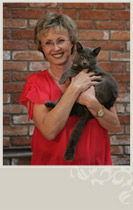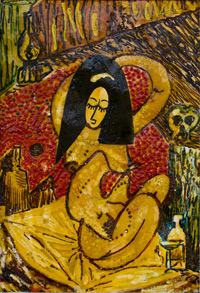O me
Zdeňka Holejšovská
born on 16.1.1950 in Usti nad Labem – Střekov

I have been painting since I was a little girl, as far as my memory can remember and already back then I perceived creation as something artistic. I began drawing and as soon as somebody asked: what is it going to be? I almost always responded: I don't know yet. And even today, although I start a painting with a certain intention, I claim – it worked out well, but it’s just by chance. Simply, I just keep working on it until I am satisfied, and when I don’t know what to improve on it, that means it’s finished.
Otherwise, I would also like to point out that mathematics horrified me, I never quite understood physics, and chemistry was from another world for me when I went to school. To top it off, I don’t even have a musical ear – so the only thing I could do was paint.
I attended all of my school years at the People’s School of Art. Just before I turned twenty I attended lessons from Dan Richter – he taught me how to draw and I admired his “realistic” paintings. At the age of twenty-five I went en plein-air with the academic painter Leopold Musil. He was truly number one en plein-air and I literally wanted to cry over my very first paintings in the Sazava region. It took me five years before I could catch the motif of a landscape.
At the time, my husband worked in Kavalier in Sazava with the father of Michal Viewegh, who was just around 11 years old back then. I was friends with his mother Slavka.
I began exhibiting in small exhibition halls, got down to work, and I fought for a permit – freelancing.
 mise The commission of the Czech Fine Arts Foundation threw me out about 5 times, in order to finally accept me out of mercy after three years. At that time I offered my paintings to the gallery Talleres de Pintura in Buenos Aires. The gallerist was a Hungarian Jew, but because he had studied in Prague, he could speak Czech, which was my pure luck. I painted pictures – boats, cities, bouquets of flowers, figures – I took photos of them and sent the offer to Carlos Hahn. I took the selected ones to Artcentre and waited for my honorarium – round and round like this for four years and then Carlos, whom I had never met in person – we only talked on the phone once – died from lung cancer. I am eternally grateful to him, as it was such a lesson to be learnt from overseas.
In the 1980s, the Japanese began visiting my atelier. The gallerist Kenji Hirasawa was interested in completely different paintings than the Argentineans. Large pastose paintings changed into small formats. Yes, the Japanese have small flats. Otherwise, they give immense freedom in creation; they don’t restrict me in any way and I truly enjoy painting for Japanese art lovers even to this very day.
mise The commission of the Czech Fine Arts Foundation threw me out about 5 times, in order to finally accept me out of mercy after three years. At that time I offered my paintings to the gallery Talleres de Pintura in Buenos Aires. The gallerist was a Hungarian Jew, but because he had studied in Prague, he could speak Czech, which was my pure luck. I painted pictures – boats, cities, bouquets of flowers, figures – I took photos of them and sent the offer to Carlos Hahn. I took the selected ones to Artcentre and waited for my honorarium – round and round like this for four years and then Carlos, whom I had never met in person – we only talked on the phone once – died from lung cancer. I am eternally grateful to him, as it was such a lesson to be learnt from overseas.
In the 1980s, the Japanese began visiting my atelier. The gallerist Kenji Hirasawa was interested in completely different paintings than the Argentineans. Large pastose paintings changed into small formats. Yes, the Japanese have small flats. Otherwise, they give immense freedom in creation; they don’t restrict me in any way and I truly enjoy painting for Japanese art lovers even to this very day. In 1999 I had an author’s exhibition of paintings in Tokyo together with Professor Ladislav Leitgeb at the Isetan Shinjuku Gallery. The almost one-month stay in Japan was a very pleasant experience. At the time, I was building a small factory for mirrors with my husband Pavel Holejšovský and son David. The company has been prospering ever since and is called Amirro s.r.o. It is now also led by my daughter Lucie.
In 1999 I had an author’s exhibition of paintings in Tokyo together with Professor Ladislav Leitgeb at the Isetan Shinjuku Gallery. The almost one-month stay in Japan was a very pleasant experience. At the time, I was building a small factory for mirrors with my husband Pavel Holejšovský and son David. The company has been prospering ever since and is called Amirro s.r.o. It is now also led by my daughter Lucie.In 2004, I received a gift from my husband, the Gallery Amirro in Počernice, where I exhibit my paintings and the paintings of my friends, such as, F.Ringo Čech, Olga Vyleťalová, Jiří Chadima, Professor Ladislav Leitgeb.Exhibitions of the following artists have also taken place at the gallery: Karl Sládek, Magdalena Křesťanova, Josef Vyleťal, Miloš Pošar, and photographer Kamil Voděra.
I would like to say that painting pictures is like creating your own world, it is another perception of life and colours give me incredible freedom. I love the motif of boats, cities and the sun – but without the viewer, at times enthusiastic, at others the tough critic, my painting would lose its meaning. You see, a painting brings pleasure twice - first when a painter fights and wins the artistic battle, and second when the viewer sees the painting and discovers the magic within it – the painter’s message.
Your Zdeňka


